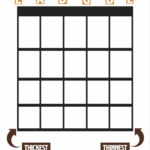Billie Joe Armstrong, the energetic frontman of punk rock giants Green Day, is as renowned for his blistering guitar riffs and catchy songwriting as he is for his raw, emotive vocals. For guitar enthusiasts and Green Day fans alike, understanding Billie Joe Armstrong’s guitar choices offers a fascinating glimpse into the sound and style of one of punk rock’s most enduring figures. This article explores the iconic guitars favored by Billie Joe, from his beloved “Blue” Stratocaster to his collection of Gibson Les Paul Juniors, and delves into the amps, effects, and accessories that contribute to his signature Green Day guitar sound.
Billie Joe Armstrong’s Electric Guitars: A Collection of Punk Rock Icons
Fernandes RST-50 Stratocaster “Blue”: The Cornerstone
Billie Joe Armstrong’s “Blue” Fernandes Stratocaster is arguably the most recognizable guitar associated with him. More than just a guitar, “Blue” is a symbol of Billie’s early beginnings and enduring passion for music. Gifted to him by his mother for his 11th birthday, purchased from George Cole of Beatnik Beatch, this wasn’t just any Stratocaster; it was the first electric guitar Billie ever owned, setting him on his path to punk rock stardom. Interestingly, prior to Billie, “Blue” belonged to David Margen, who played bass with Santana, adding a layer of rock history to this already iconic instrument.
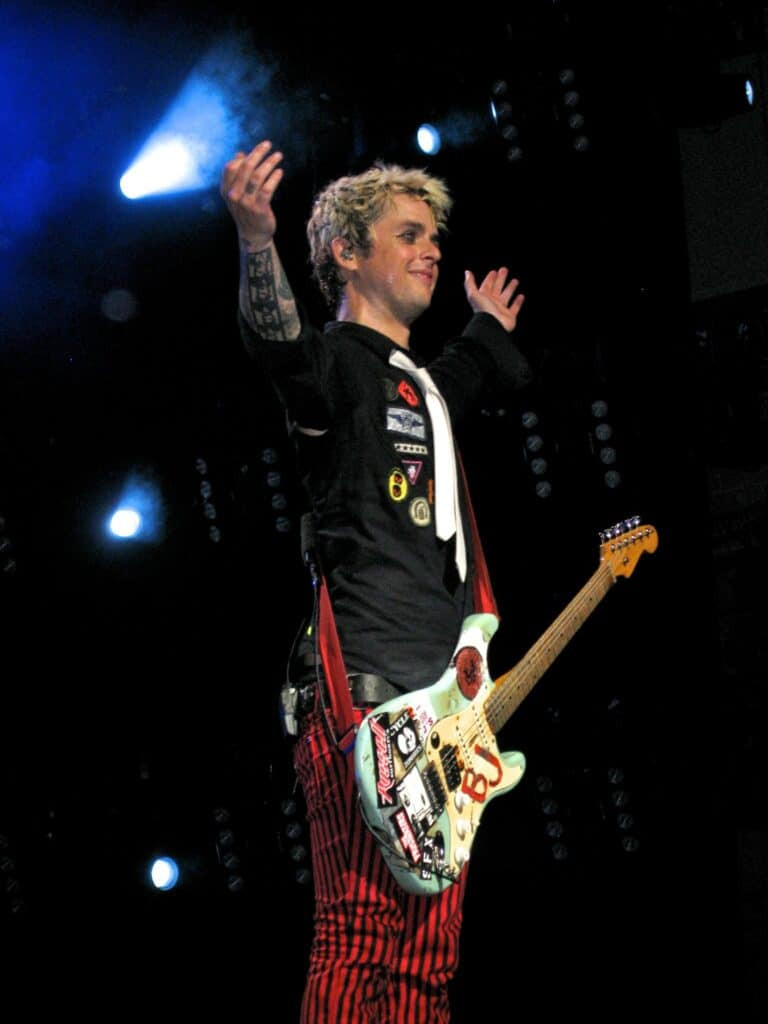 Billie Joe Armstrong passionately playing his blue Fernandes Stratocaster, adorned with numerous stickers.
Billie Joe Armstrong passionately playing his blue Fernandes Stratocaster, adorned with numerous stickers.
Specifications and Evolution of “Blue”
“Blue” isn’t a Fender Stratocaster but a Fernandes RST-50, known for its quality and Strat-like design. Finished in a Daphne Blue-esque color, what truly sets “Blue” apart is its evolution over time. Covered in an array of stickers accumulated throughout Billie’s career, each sticker tells a story, marking moments and memories. Sonically, “Blue” has also undergone changes. Initially equipped with a Bill Lawrence humbucker in the bridge for a hotter, punk rock tone, this pickup was unfortunately damaged at Woodstock ’94. It was then replaced with a white Seymour Duncan JB humbucker, a pickup known for its versatility and powerful output. In recent years, it’s highly likely Billie has transitioned to the more contemporary Duncan JB SH-4, a favorite of his that appears in many of his guitars, ensuring consistent tone and performance.
 Billie Joe Armstrong in 1994, playing his sticker-covered blue Stratocaster guitar during Green Day's early success.
Billie Joe Armstrong in 1994, playing his sticker-covered blue Stratocaster guitar during Green Day's early success.
1956 Gibson Les Paul Junior “Floyd”: The Treasured Workhorse
Billie Joe Armstrong’s love for Gibson Les Paul Juniors is well-documented, and leading the pack is “Floyd,” a 1956 Les Paul Junior. Acquired in 2000 just before the recording of Green Day’s album Warning, “Floyd” quickly became Billie’s main Les Paul Junior and a studio favorite. He discovered “Floyd” at a guitar show in San Rafael, recognizing its special qualities immediately. Coming from a Fender-heavy background at the time, “Floyd” offered Billie a different sonic palette and playing experience, becoming an integral part of his sound.
“Floyd’s” Unique Character
“Floyd” boasts a classic dark sunburst single-cutaway body and the raw power of a single vintage P-90 pickup in the bridge position. This configuration delivers a punchy, mid-range focused tone perfect for punk rock. However, “Floyd” is now considered too valuable for the rigors of live performances. Billie has officially retired “Floyd” from stage use, preserving it as a cherished studio instrument and a testament to the golden era of Gibson guitars.
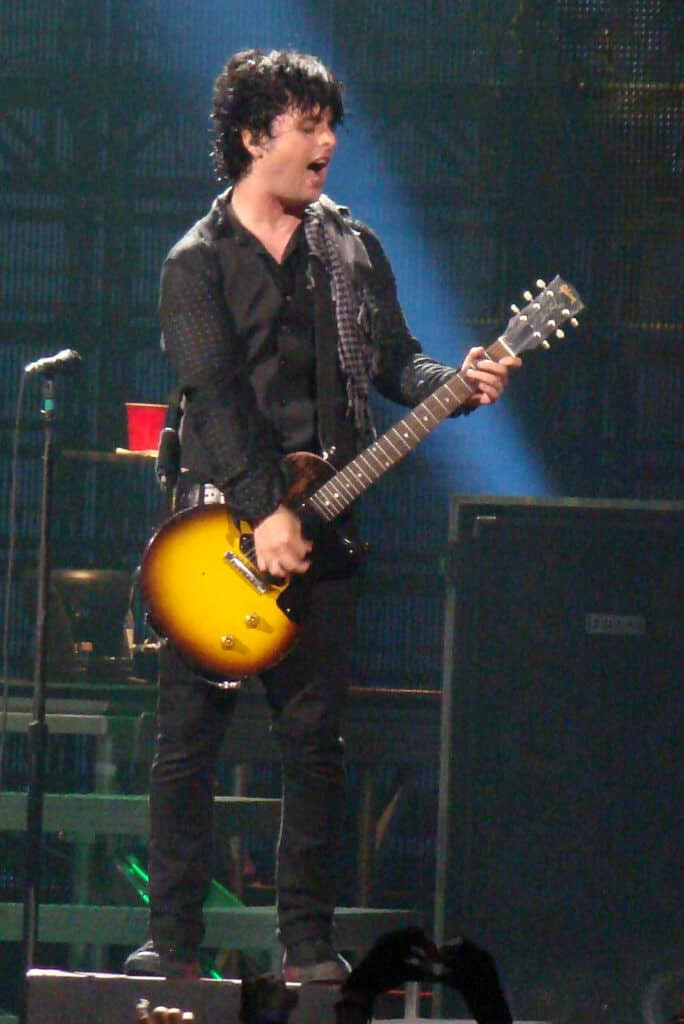 Billie Joe Armstrong energetically performing live with his 1956 Gibson Les Paul Junior "Floyd", a favorite stage and studio guitar.
Billie Joe Armstrong energetically performing live with his 1956 Gibson Les Paul Junior "Floyd", a favorite stage and studio guitar.
1959 Gibson Les Paul Junior: The Stage Staple
While “Floyd” rests comfortably offstage, Billie’s 1959 Gibson Les Paul Junior steps into the spotlight as his most frequently used and recognizable Les Paul Junior for live performances. This guitar shares the no-nonsense attitude of a Les Paul Junior, featuring a single Seymour Duncan Antiquity P-90 pickup in the bridge position, mounted on a black body. It’s another example of Billie’s preference for the raw, direct tone of a single P-90 in the bridge for punk rock power.
Visual Marks of a Road-Worn Favorite
This ’59 Les Paul Junior is visually distinguished by wear and personal touches that speak to its years of service on stage. A noticeable wear patch above the pickguard tells the story of countless energetic performances, and a “Mary” sticker placed just behind the bridge adds a personal, almost talismanic element to the instrument.
Gibson Billie Joe Armstrong Les Paul Junior Doublecut: Signature Sound
Billie Joe Armstrong’s affinity for Les Paul Juniors extends beyond vintage finds to his own signature model. With over 20 Les Paul Juniors in his collection, mostly vintage models from the 1950s in black or TV-cream finishes, Billie’s passion for this guitar is undeniable. He praises their consistent quality and “cool” factor, highlighting their inherent rock and roll spirit.
The Signature Model – A Modern Classic
Among his Juniors, the Gibson Billie Joe Armstrong Les Paul Junior Doublecut stands out. Produced for a limited time between 2012 and 2013, this first version of his signature model offered a unique take on the classic Junior. It featured a vibrant glossy yellow finish on a double-cutaway mahogany body, a mahogany neck, and a rosewood fretboard. Unique aesthetic touches included a black pickguard with an embedded skull design, adding a punk rock edge straight from the factory. Sonically, it was equipped with a special H-90 pickup, designed by Gibson to Billie’s specifications, aiming to capture his ideal P-90 tone with a touch more versatility.
 Billie Joe Armstrong playing his signature yellow Gibson Les Paul Junior, showcasing its double-cutaway design.
Billie Joe Armstrong playing his signature yellow Gibson Les Paul Junior, showcasing its double-cutaway design.
Fender Telecaster Custom: The Reliable Backup
For live performances, reliability is key, and Billie Joe Armstrong employs custom-built Fender Telecaster Customs as backups to his prized “Blue” Strat. These aren’t standard off-the-shelf Telecasters but are assembled by Billie’s guitar technician to meet his specific needs and preferences, ensuring consistent performance should “Blue” need a break.
Built for Functionality
These Telecasters feature black bodies, Flat Mount bridges, white WD pickguards, and are loaded with Duncan JB SH-4 pickups in the bridge position, mirroring the pickup choice in “Blue” and many of his other guitars for tonal consistency. Control-wise, they are simplified to just a volume knob, reflecting Billie’s straightforward approach to guitar playing – focusing on raw energy and direct tone. Billie reportedly keeps several of these Telecasters ready for action, often gifting them to fans and friends after shows, further cementing his connection with his audience.
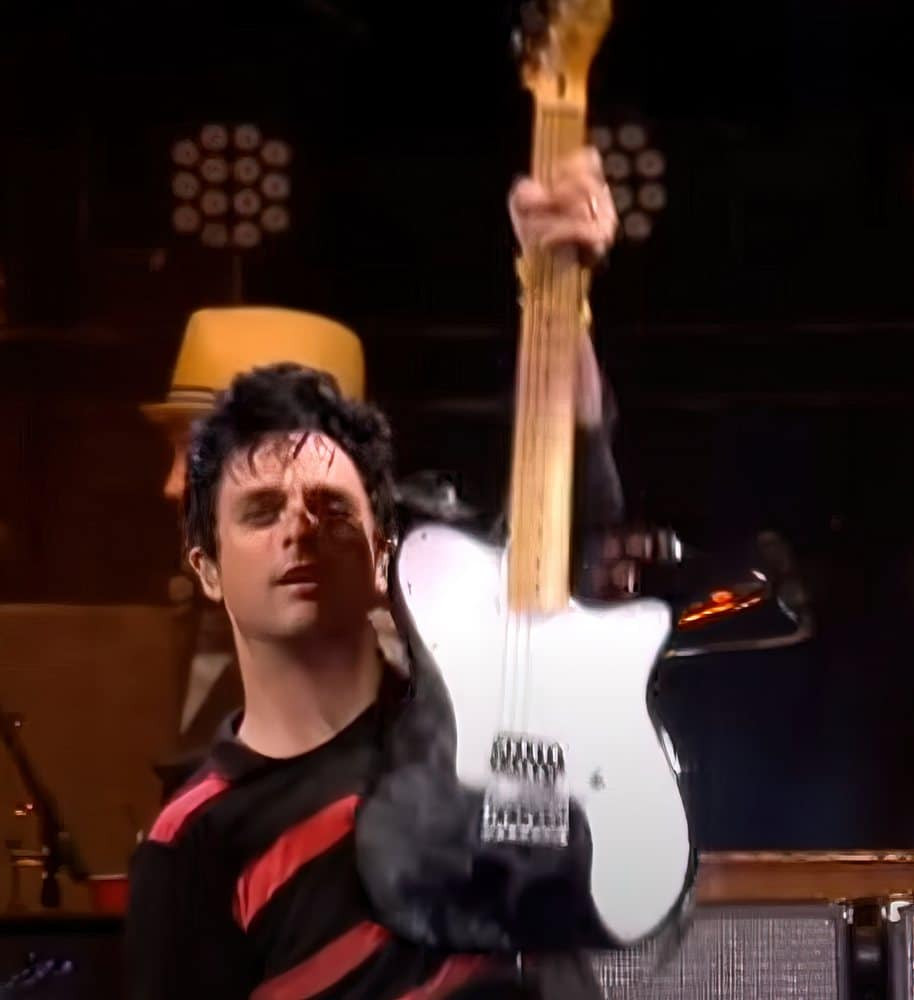 Billie Joe Armstrong holding a black Telecaster guitar at the Reading Festival, showcasing his preference for simple, powerful instruments.
Billie Joe Armstrong holding a black Telecaster guitar at the Reading Festival, showcasing his preference for simple, powerful instruments.
Gibson ES-135: Semi-Hollow Ventures
While primarily known for solid-body guitars, Billie Joe Armstrong has also explored semi-hollow instruments like the Gibson ES-135. Notably seen in the music video for Green Day’s song “Redundant,” this ES-135, likely an early 90s model, showcases a different facet of Billie’s guitar interests. Finished in red and equipped with two P-100 pickups, the ES-135 offers a warmer, more resonant tone compared to his solid-body guitars, yet still capable of delivering rock and roll punch. A quirky detail from the “Redundant” video shows Billie dealing with a strap button issue by taping the guitar strap directly to the guitar, a testament to his on-the-fly, punk rock problem-solving.
A Unique White ES-135
More recently, Billie has been seen with a custom-made, all-white ES-135. According to his guitar tech, this is a one-of-a-kind instrument built by Gibson specifically for Billie, highlighting his ongoing relationship with the company and his willingness to explore different guitar types.
 Billie Joe Armstrong playing a red Gibson ES-135 guitar in the "Redundant" music video, highlighting his use of semi-hollow guitars.
Billie Joe Armstrong playing a red Gibson ES-135 guitar in the "Redundant" music video, highlighting his use of semi-hollow guitars.
Gibson ES-335 (Black, Dot): A Brief Stage Appearance
Around 2009, Billie Joe Armstrong incorporated a black Gibson ES-335 into his live rig. This guitar, appearing to be a standard ES-335 in black finish with dot inlays, had a few modifications typical of Billie’s no-frills approach. He removed two of the tone knobs, simplifying the controls, and added two stickers – one of a clown and another with the number “9” – personalizing the instrument in his signature style. While not a mainstay, its appearance demonstrates Billie’s occasional forays into the classic ES-335 sound.
Fender Stratocaster (Class 13): Another Backup in the Arsenal
Another Stratocaster that appeared in Billie’s hands around 2009, dubbed the “Class 13” Strat, served likely as another backup to his main “Blue” Fernandes. This Fender Stratocaster received similar modifications to “Blue,” including the crucial addition of a humbucker pickup in the bridge position for high-output rock tones. Billie also removed the lacquer from the fretboard, possibly for a smoother playing feel, and replaced the bridge saddles with more modern, blocky versions. A “Class 13” sticker behind the bridge gave this guitar its distinctive name.
Gibson Les Paul Special DC (White, Skull): Prototype and Stage Guitar
The white Gibson Les Paul Special Double Cutaway with a skull graphic holds a significant place in Billie Joe Armstrong’s guitar history. This guitar was a main touring instrument in 2010 but had been with Billie and his tech since 2005. Interestingly, it served as a prototype for the later Billie Joe Armstrong Les Paul Junior signature model released in 2012. Featuring a white finish, tortoise pickguard, and a skull design spray-painted behind the bridge, this Les Paul Special offered a glimpse into the design elements that would later define his signature model. According to a Reverb auction listing from Green Day’s 2017 gear sale, the development of this guitar involved a two-year prototyping process with Gibson to recreate the feel and specifications of vintage 1950s Les Paul Juniors, emphasizing Billie’s dedication to capturing a specific classic tone and feel.
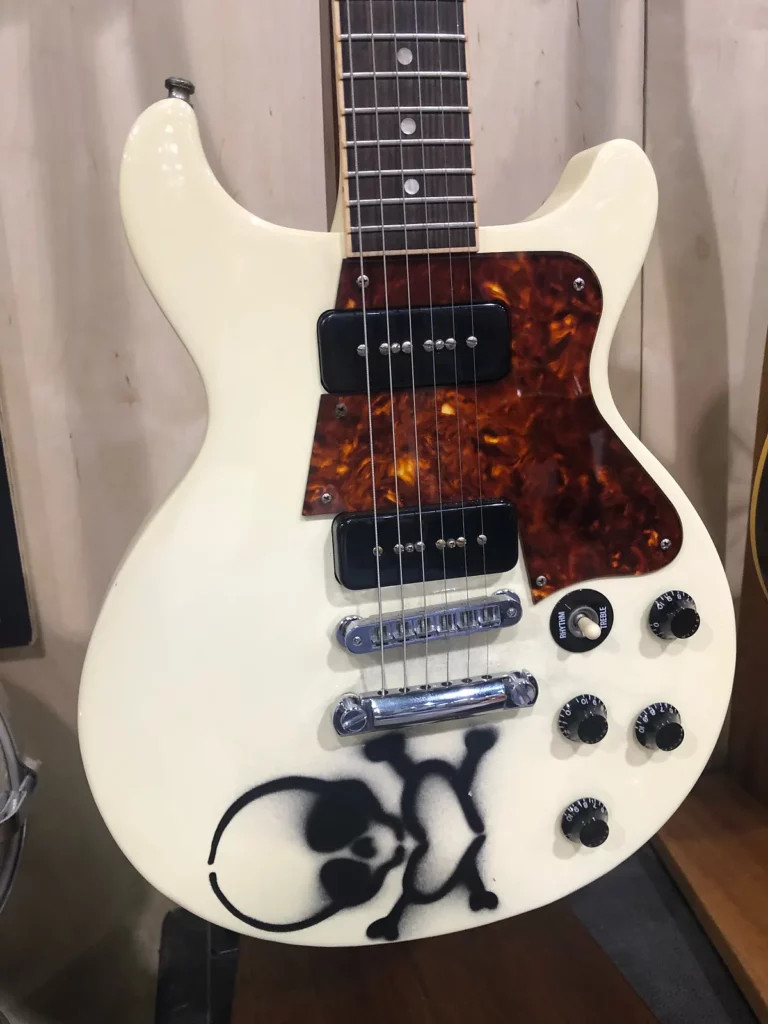 Close-up of Billie Joe Armstrong's white Les Paul Special DC guitar with a skull graphic, a prototype for his signature model.
Close-up of Billie Joe Armstrong's white Les Paul Special DC guitar with a skull graphic, a prototype for his signature model.
Maton 1958 MS500 50th Anniversary: An Australian Connection
In 2013, Billie Joe Armstrong added an Australian-made Maton MS500 50th Anniversary guitar to his touring collection. The MS500 50th Anniversary model, identifiable by a custom inlay at the 12th fret, was released to celebrate 50 years of the MS500 model. Maton guitars are known for using Australian tonewoods, and Billie’s MS500 features a solid quandong wood body, Queensland maple neck, and Indian rosewood fretboard. Pickup-wise, it’s equipped with a Maton Vintage Humbucker in the bridge and a Vintage Single Coil in the neck, offering a unique tonal flavor compared to his usual American guitars.
Rickenbacker 360: Adding Jangle to the Punk
Around 2013, Billie expanded his guitar palette further with a black Rickenbacker 360. Since its acquisition, this Rickenbacker has become a frequent stage companion, adding a distinctive jangly, chime-like quality to Green Day’s sound, contrasting with the more aggressive tones of his Strats and Les Paul Juniors. Billie’s Rickenbacker 360 is mostly stock, featuring the signature “Hi-Gain” single-coil pickups that contribute to its bright and articulate tone. The main modification Billie made was simplifying the controls by removing all but the master volume knob. Initially, the empty control holes were covered with black tape, but later, a custom pickguard was made to provide a cleaner, more finished look.
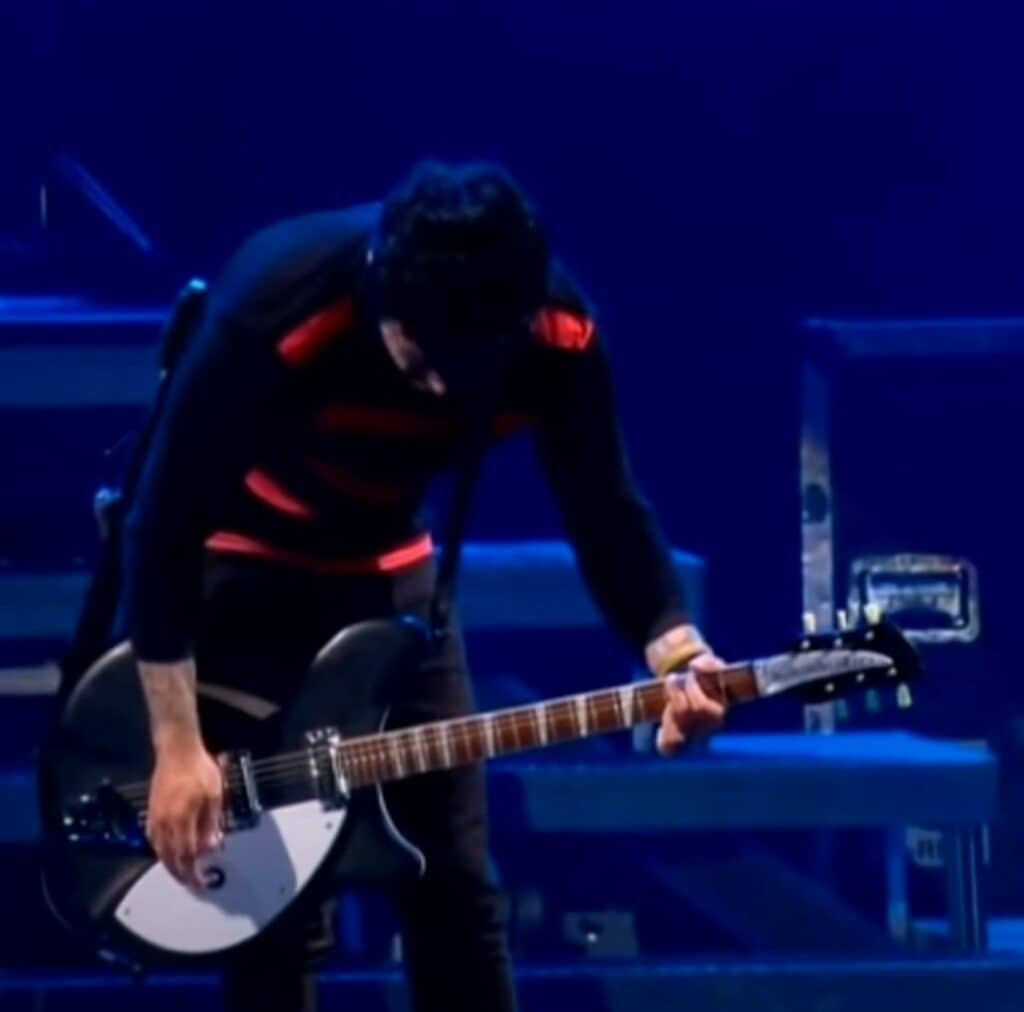 Billie Joe Armstrong playing his black Rickenbacker 360 guitar, known for its distinctive jangle and chime.
Billie Joe Armstrong playing his black Rickenbacker 360 guitar, known for its distinctive jangle and chime.
Billie Joe Armstrong’s Acoustic Guitars: Unplugged Moments
Gibson Billie Joe Armstrong J-180: Signature Acoustic
For acoustic performances, Billie Joe Armstrong primarily relies on his signature Gibson Billie Joe Armstrong J-180. Released in 2011, this model is styled after the classic J-180 Everly Brothers model, but with subtle differences. Visually, the BJA J-180 features a traditionally shaped bridge and unique fretboard inlays compared to the Everly Brothers version. Instead of black pickguards, Billie’s signature model uses tortoiseshell pickguards, adding a touch of classic elegance. Tonewoods include a Sitka spruce top with Eastern maple back and sides, and a mahogany neck with an Indian rosewood fingerboard, a combination known for balanced tone and projection. For amplified acoustic sound, the J-180 is equipped with a Fishman Matrix VT preamp and piezo pickup system.
1970 Martin D-41: “21 Guns” Acoustic
During the recording of Green Day’s 21st Century Breakdown album in 2008/09 in Hollywood, Billie purchased a 1970 Martin D-41 acoustic guitar. This Martin D-41 became the acoustic voice of the powerful track “21 Guns.” In 2017, Billie auctioned off this guitar through Reverb, where it sold for $5,950, giving a fan the opportunity to own a piece of Green Day history.
Billie Joe Armstrong’s Guitar Amps: From Plexi Roar to Modern Punch
Peavey Musician 400 Series & Gallien Krueger 250RL: Early Amps
In Green Day’s formative years, Billie’s amp choices were more modest. A Peavey Musician 400 Series amp is visible in a photo from the vinyl edition of the 39/Smooth album, suggesting its use in pre-recording days. For early gigs and likely the recording of 39/Smooth, Billie used a Gallien Krueger 250RL, a solid-state amp known for its compact size and clean tones, perhaps pushing it for overdrive or using pedals for distortion in Green Day’s early raw sound.
Marshall JCM 900: Kerplunk Era Crunch
Around 1992, coinciding with the Kerplunk album, Billie Joe Armstrong transitioned to Marshall amplification, specifically the JCM900 series. The JCM900, known for its higher gain capabilities compared to older Marshalls, became a part of Green Day’s evolving sound. It was used during the Kerplunk era and even seen in the “Basket Case” music video during the Dookie period, indicating its continued use in the early stages of their breakthrough success.
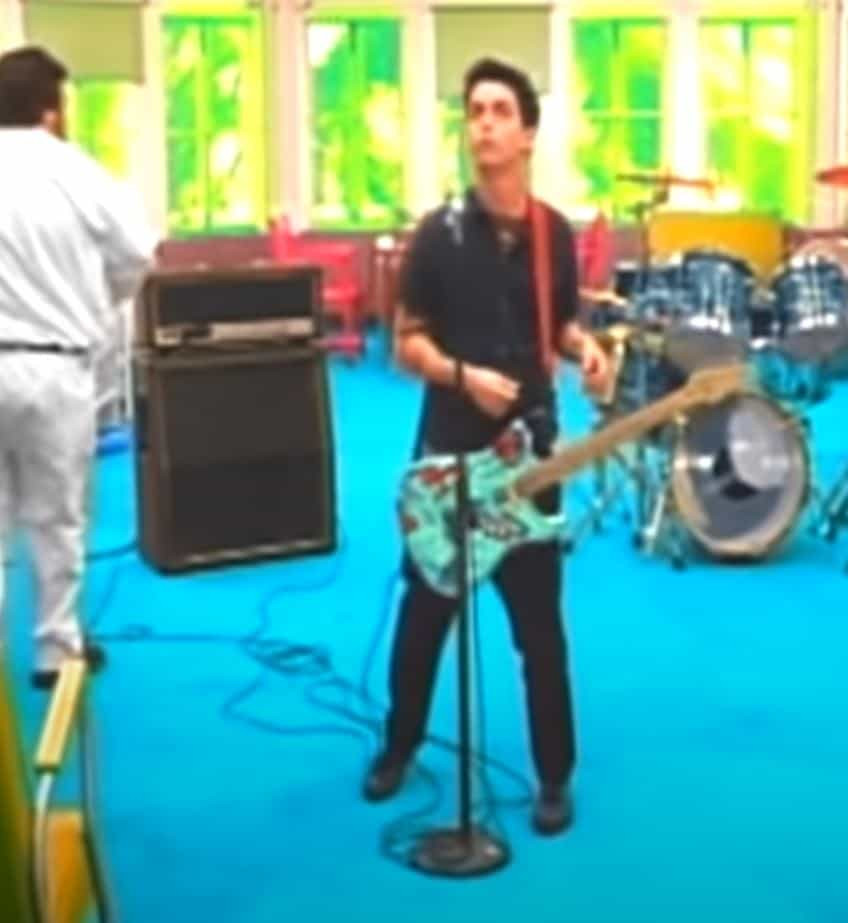 A de-branded Marshall JCM 900 amplifier subtly placed behind Billie Joe Armstrong in the "Basket Case" music video.
A de-branded Marshall JCM 900 amplifier subtly placed behind Billie Joe Armstrong in the "Basket Case" music video.
Marshall Plexi 1959SLP “Pete” w/ Bradshaw Gain Mod: The Dookie Sound and Beyond
The Marshall Plexi 1959SLP nicknamed “Pete” is arguably the most crucial amp in Billie Joe Armstrong’s setup and a key component of the iconic Green Day guitar sound. During the Dookie era (1994), Billie began using this Marshall 1959 reissue, distinguished by the word “PETE” spray-painted on the front. Crucially, “Pete” was modified by Martin Golub of LA Sound Design with the Bradshaw Gain Mod, replacing one of the master volumes with a gain knob. This modification allowed Billie to achieve higher gain tones at lower volumes, crucial for both studio recording and stage performance. “Pete” was used extensively on most Green Day albums and remains a central part of his live rig, now sporting a pink finish.
Marshall Plexi 1959SLP #2 “Meat”: Pete’s Stage Partner
Complementing “Pete” on stage is another Marshall Plexi 1959SLP, nicknamed “Meat.” Painted silver and featuring the SE Lead mod, “Meat” serves as Billie’s second main amp, running alongside “Pete” to create a fuller, more powerful live guitar sound. The combination of “Pete” and “Meat” provides a blend of modified Plexi tones that define Billie Joe Armstrong’s live guitar rig.
 A side-by-side view of Billie Joe Armstrong's "Pete" and "Meat" Marshall Plexi amplifiers, highlighting his core amp setup.
A side-by-side view of Billie Joe Armstrong's "Pete" and "Meat" Marshall Plexi amplifiers, highlighting his core amp setup.
Fender Twin & Fender Bassman & Divided by 13: Studio Tones
Beyond his core Marshall setup, Billie has utilized other amps in the studio to achieve specific tones. A 1958 Fender Twin, known for its clean headroom and sparkling Fender tone, has likely been used for cleaner guitar parts. A Fender Bassman, a tweed classic known for its warm overdrive, was used on the album Nimrod, adding a different flavor to the guitar tracks. For 21st Century Breakdown, Billie employed a Divided by 13 combo amp, boutique amps known for their vintage-inspired tones and responsiveness, further expanding his sonic palette in the studio. For speaker cabinets, Billie typically uses Marshall 1960B cabinets loaded with Celestion Vintage 30 speakers, a standard choice for rock guitarists for their balanced frequency response and ability to handle high volumes.
Billie Joe Armstrong’s Guitar Effects: Less is More
Billie Joe Armstrong is known for a relatively minimalist approach to guitar effects, preferring the raw sound of his guitars and amps. However, a few effects pedals have made appearances in his rig at various times:
- Boss TR-2 Tremolo: For subtle tremolo effects.
- Ibanez CF7 Chorus Flanger: For chorus and flanger textures, adding modulation to his sound.
- Ibanez TS9 Tube Screamer: A classic overdrive pedal, likely used to push his amps further into distortion for solos or heavier sections.
- Boss BD-2 Blues Driver Overdrive: Another overdrive option, possibly for a slightly different flavor of overdrive than the Tube Screamer, offering a more transparent and dynamic boost.
Billie Joe Armstrong’s Guitar Strings and Picks: Essential Details
Guitar Strings: Billie Joe Armstrong currently uses Ernie Ball Super Slinky .010 – .046 gauge strings. These are a popular choice for rock guitarists, offering a balance of playability and tone. While his string gauge preference in earlier years isn’t definitively documented, it’s likely he has used similar gauges throughout his career.
Guitar Picks: Currently, Billie’s guitar tech indicates he uses Dunlop .73mm Tortex picks with custom designs. In earlier days, he seemed to favor the slightly heavier .88mm Dunlop Tortex green picks, often seen tucked into his microphone stand for easy access during performances.
Conclusion:
Billie Joe Armstrong’s guitar gear reflects his raw, energetic punk rock style. From his iconic “Blue” Stratocaster, a constant companion throughout his career, to his favored Gibson Les Paul Juniors and powerful Marshall amps, his choices prioritize tone, reliability, and a direct connection to his audience. While his effects usage is minimal, the carefully selected guitars, amps, and essential accessories form the foundation of the unmistakable Green Day guitar sound, inspiring generations of punk rock guitarists.

